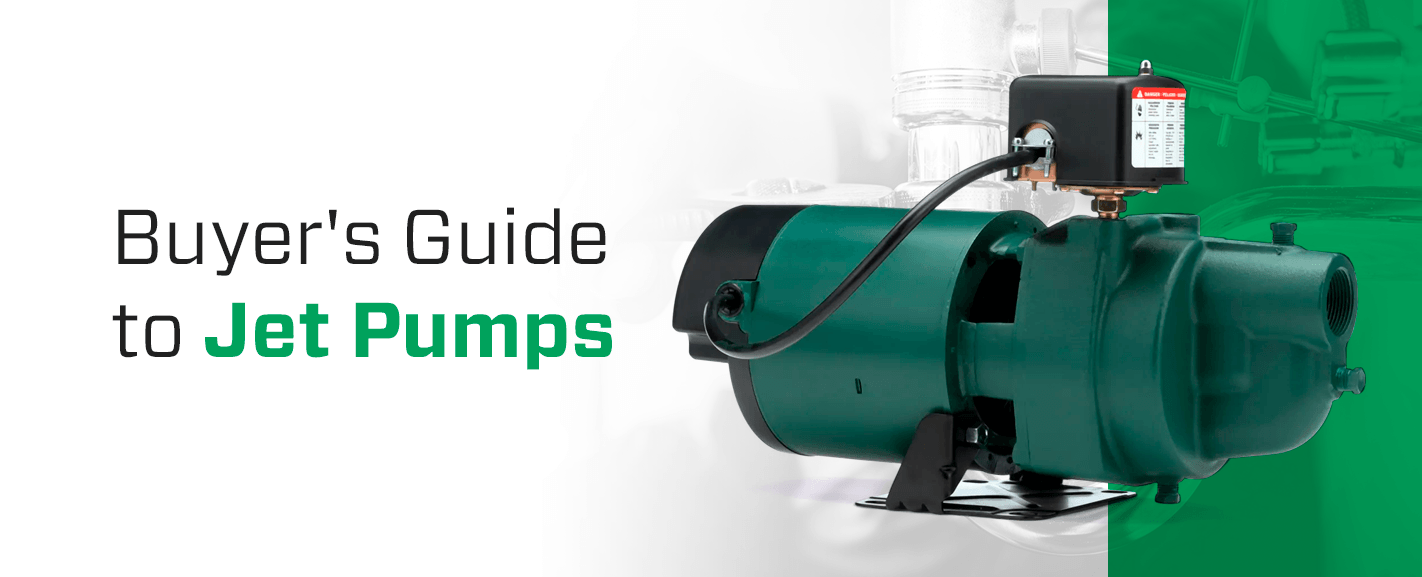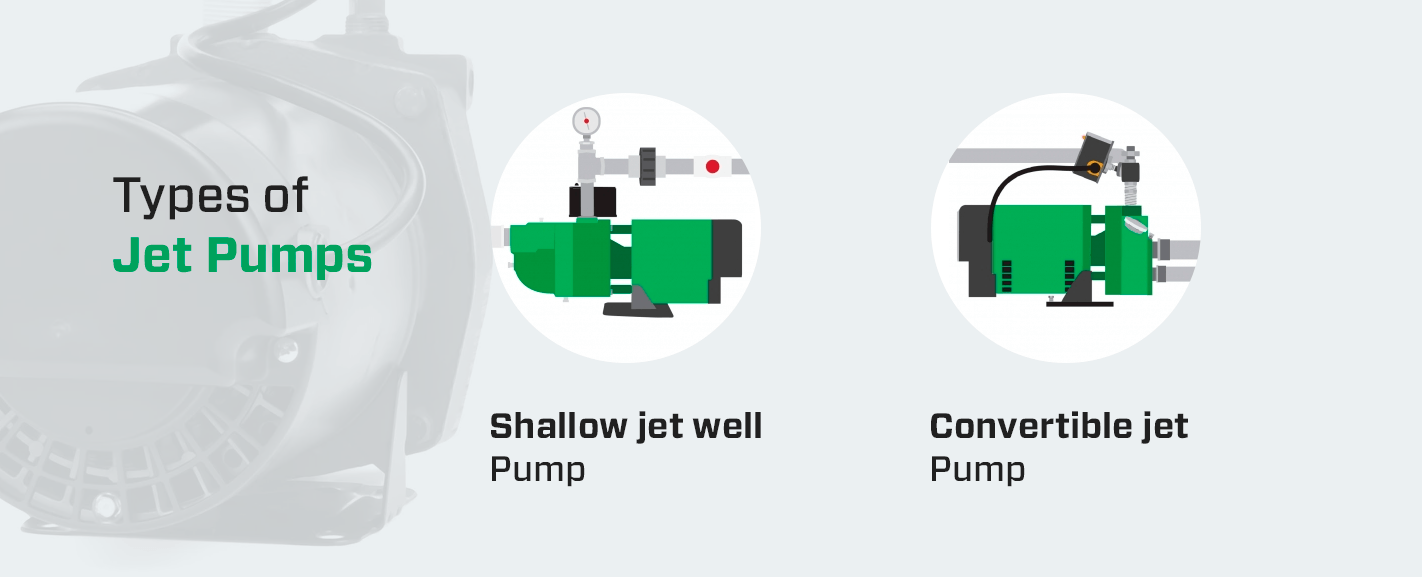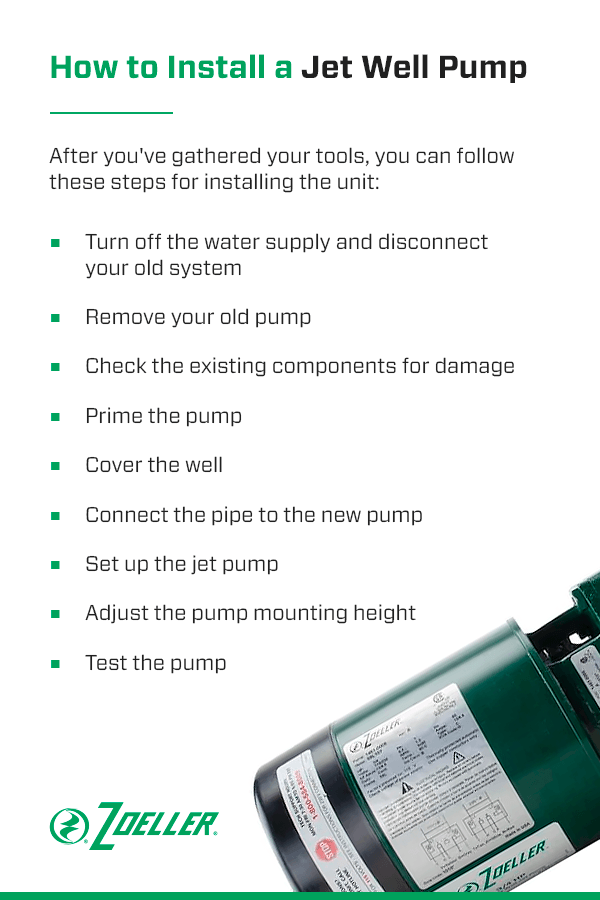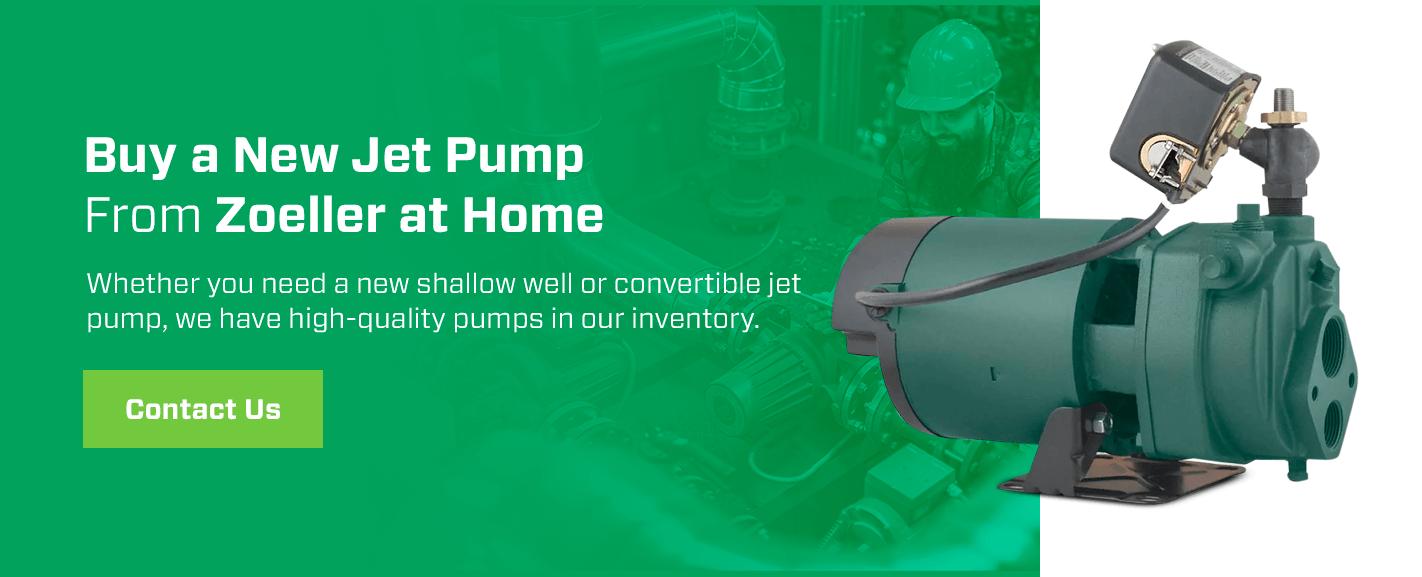Guide d'achat des pompes à jet
1 décembre 2021
Si vous devez remplacer votre pompe de puits, envisagez d'investir dans un produit efficace et de haute qualité. pompe à jet. Comme il ne pénètre pas sous terre comme une unité submersible, il est plus facile à nettoyer et à réparer. En fonction de la profondeur de votre puits ou de votre source d'eau, vous pouvez choisir soit un jet de puits peu profond, soit une configuration convertible. Ce guide des pompes de puits peut vous aider à trouver la pompe adaptée à votre application.
Comment fonctionne une pompe à jet ?
Une pompe à jet de puits est un appareil hors sol qui utilise la force centrifuge et l'éjection pour puiser l'eau d'un puits ou d'une autre source. Cet appareil souffle de l'eau à travers un venturi pour établir un vide qui aspire l'eau et l'envoie de l'autre côté avec une turbine. À mesure que la pression augmente, l'unité peut puiser l'eau d'un puits à une profondeur importante.
À quoi sert une pompe à jet de puits ?
Le but d'une pompe à jet de puits est de fournir de l'eau pour ces applications domestiques ou agricoles :
- Apporter de l'eau potable aux éviers, aux douches, aux baignoires et aux tuyaux d'une maison à partir d'un puits.
- Fournir de l'eau pour un arroseur pour entretenir un jardin.
- Allumer un radiateur à eau.
- Donner de l'eau chaude à votre maison.
- Eau d'irrigation pour garder votre grande superficie propre et saine.
- Éliminer l'eau indésirable d'un étang ou d'un autre plan d'eau.
- Augmente la pression de l'eau pour une utilisation à l'intérieur de la maison ou sur le terrain.

Types de pompes à jet
Considérez les caractéristiques de chaque type de pompe à jet pour trouver le produit approprié à votre propriété :
- Pompe pour puits à jet peu profond : Une fonte pompe de puits à jet peu profond puise l'eau d'un puits de 25 pieds de profondeur ou moins. L'unité se trouve dans un boîtier monté sur le puits et pompe de l'eau à un débit de 15 gallons par minute. La puissance d'un puits peu profond est de trois quarts de chevaux et fonctionne généralement à 115 ou 230 volts, selon les besoins électriques de votre maison.
- Pompe à jet convertible : Une pompe à jet convertible en fonte peut accueillir à la fois des puits et d'autres sources d'eau jusqu'à 70 pieds de profondeur. Le puissance pour une pompe de puits à jet convertible est de 1 CV et peut puiser de l'eau à un débit de 10,6 gallons par minute. Comme l’unité de puits peu profond, une unité convertible peut fonctionner à 230 ou 115 volts. Il comporte deux trous pour les tuyaux qui peuvent aspirer de l'eau pour les applications de puits peu profonds et profonds.
Chaque type comporte les composants suivants :
- Moteur électrique: Ce composant alimente la pompe de puits d'eau grâce à sa connexion à l'alimentation électrique de votre maison.
- Turbine : La turbine comporte des pales rotatives qui utilisent la force centrifuge pour pousser l’eau hors de la pompe.
- Clapet de pied : Un clapet de pied fait circuler le débit d'eau dans une seule direction dans la pompe. Même lorsque l'unité ne fonctionne pas, le clapet de pied maintient la pression et l'amorçage de la pompe.
- Clapet anti-retour : Ce composant empêche l'eau de retourner dans la pompe après qu'un tuyau l'a fait sortir.
- Pressostat : Un pressostat ouvre et ferme les contacts électriques de la pompe en fonction de sa pression. En fonction de la consommation d'eau, l'unité active les connexions à la pression inférieure ou « de coupure » et les désactive au niveau supérieur ou de « coupure ».
- Réservoir d'air: Un réservoir d’air sous pression stocke la pression pour créer une quantité suffisante pour votre pompe. Sans la pression appropriée, l’appareil pourrait faire des cycles courts ou s’allumer et s’éteindre trop fréquemment.
- Éjecteur: Ce composant comporte une buse et un venturi qui établissent un vide pour faire remonter l'eau du puits contre la force de gravité.
Si jamais vous devez remplacer votre pompe à jet, il est également utile de remplacer ces composants car ils doivent compléter le modèle et le fabricant de votre produit spécifique. Même si la plupart de ces pièces se trouvent à l'intérieur d'une pompe de puits à jet peu profond, elles sont également fournies dans un kit d'éjection pour une pompe convertible.
Avantages d'une pompe à jet de puits
Posséder une pompe à jet de puits présente de nombreux avantages et chaque type de produit de puits à jet présente ses propres avantages. Voici les avantages d’une pompe pour puits à jet peu profond :
- Il peut accueillir des puits de plus petit diamètre.
- Il est léger et facile à installer.
- Il contient des matériaux durables qui peuvent résister à la rouille, à la corrosion et à l'usure.
- Il présente une mécanique simple qui ne nécessite pas beaucoup d’entretien.
- Puisqu’il a une puissance inférieure, il peut vous aider à économiser de l’argent sur vos factures de services publics.
En comparaison, considérons les avantages d’une pompe à jet convertible :
- Il peut puiser l’eau de puits peu profonds et profonds afin que vous puissiez l’utiliser pour diverses applications.
- Il comporte également des matériaux durables et résistants à la corrosion.
- Il a une puissance plus élevée, ce qui lui permet de puiser de l'eau plus rapidement.
Maintenant que nous comprenons les capacités et les avantages des pompes à jet pour puits peu profonds et des pompes à jet convertibles, nous allons vous expliquer comment déterminer quelle pompe à jet convient à votre application.

Comment choisir la bonne pompe à jet
Si vous ne savez pas quel type d'unité vous avez besoin pour votre propriété résidentielle, envisagez de la remplacer par le même type que vous possédez déjà. Vous trouverez peut-être un produit similaire doté d’une nouvelle technologie, mais vous voudrez peut-être vous demander si votre plomberie peut accueillir un nouveau système. Le fabricant peut vous conseiller sur les unités qui fonctionneraient efficacement pour votre approvisionnement en eau.
Lorsque vous recherchez une pompe à jet, tenez compte de ces facteurs :
- Profondeur du puits : La profondeur de votre puits ou de votre source d'eau peut vous aider à déterminer de quelle pompe à jet votre propriété a besoin. Vous souhaiterez peut-être mesurer la profondeur de votre puits avant d’acheter un nouveau produit jet. Vous pouvez prendre une ligne de pêche ou une longue ficelle et attacher un poids au bout, en le laissant tomber plus loin dans le sol jusqu'à ce que vous ne sentiez plus le poids. La longueur de la conduite correspond à l’endroit où commence l’eau de votre puits.
- Puissance : La puissance d'une pompe de puits détermine la profondeur à laquelle elle peut puiser l'eau et la pression qu'elle peut maintenir. Si votre appareil a une puissance plus élevée, il peut vous fournir une pression d’eau plus fiable pour vos appareils et appareils d’eau. Vous pouvez connaître la puissance de l’unité souhaitée sur son emballage.
- Les besoins en eau de votre propriété : La pompe à jet doit fournir de l’eau au même débit que celui requis par l’appareil ou l’appareil. Si l'appareil expulse trop de pression, cela peut endommager votre système d'arrosage ou votre machine à laver. Même s'il semble logique qu'une pompe à jet convertible soit meilleure car elle a une puissance plus élevée, elle peut endommager vos appareils qui n'ont pas une capacité de pression élevée.
- La taille du ménage: Le but d'un pompe de puits est de fournir suffisamment d’eau pour les appareils et accessoires de votre propriété. Pensez au nombre de personnes qui vivent dans votre maison et aux sources d’eau qu’elles utilisent. Si vous remplacez votre unité, vous devrez peut-être investir dans une plus grande taille si vous avez agrandi votre famille ou installé de nouveaux appareils électroménagers.
Chez Zoeller at Home, nous avons une équipe d'experts qui se feront un plaisir de vous aider à trouver la meilleure pompe à jet pour votre application. Tu peux contactez-nous directement, ou utilisez notre fonction de chat en direct.
Applications des pompes pour puits à jet peu profond
Une pompe de puits à jet peu profond extrait efficacement l’eau des puits de moins de 25 pieds de profondeur. Il a généralement besoin de moins de 1 CV pour fonctionner et il ne fournit pas autant de pression d'eau qu'une configuration à jet convertible.
Outre les puits, cette unité peut également éliminer l’excès d’eau d’un fossé de drainage ou d’un étang. Votre propriété pourrait bénéficier de ce produit après de fortes pluies qui pourraient inonder votre cour ou ses environs. Il peut également fournir de l’eau que vous pouvez faire bouillir pour la boire en cas d’urgence et de catastrophe naturelle.
Applications des pompes à jet convertibles
Une pompe à jet convertible peut extraire l'eau de puits et d'autres sources, telles que des ruisseaux, des rivières et des lacs, entre zéro et 70 pieds de profondeur. Ça peut aussi fournir une pression d’eau constante pour les différents appareils électroménagers et sanitaires dans tout votre espace de vie. Vous pourriez bénéficier de cette unité sur votre propriété si la nappe phréatique de votre puits fluctue ou si vous avez un puits profond qui nécessite une puissance plus élevée.
Il y a des coûts supplémentaires associés à un professionnel pour installer votre pompe à jet pour vous. Vous pouvez économiser en apprenant à installer vous-même une pompe à jet de puits dans notre guide étape par étape.

Comment installer une pompe de puits à jet
Une pompe de puits hors sol est plus pratique à installer par vous-même que d’autres configurations. Avant d'installer votre appareil, c'est une bonne idée de consulter le manuel d'instructions fourni dans l'emballage pour vous assurer de l'installer correctement. Les exigences électriques et de plomberie de votre produit dépendent de son type, de son modèle et de son fabricant.
En général, vous aurez besoin du matériel suivant :
- Pinces pour connecter les boulons et écrous à la pompe.
- Tuyaux pour aller du puits à vos applications d’eau appropriées.
- Connecteurs à sertir pour maintenir la tuyauterie à la pompe du puits.
- Pinces à dénuder pour couper les fils et installer l'électricité jusqu'à la pompe du puits.
- Seau pour récupérer l'eau qui sort de votre ancienne pompe.
Après avoir rassemblé vos outils, vous pouvez suivre ces étapes pour installer l'unité :
- Coupez l'alimentation en eau et débranchez votre ancien système : Avant de remplacer votre ancienne pompe de puits par une neuve, il est essentiel de couper l'alimentation en eau pour éviter d'endommager votre puits. Vous pourriez également être gravement blessé si vous êtes électrocuté, et votre approvisionnement en eau peut être contaminé s'il continue de fonctionner. Vous devez également débrancher les fils électriques du pressostat et la conduite d'aspiration de la tête de la pompe et relâcher la pression de votre unité existante.
- Retirez votre ancienne pompe : Si vous remplacez votre pompe, retirez l'ancienne du boîtier au-dessus de votre puits. Vidangez les liquides et la pression de la pompe, en gardant la conduite de refoulement sécurisée pour éviter les dommages matériels et les blessures. Il est utile d'avoir un seau sous l'ancienne pompe pour pouvoir contrôler les liquides qui en sortent.
- Vérifiez les composants existants pour déceler tout dommage : Tant que vos canalisations et conduites sont intactes, vous pouvez les utiliser pour votre nouvelle pompe. S’ils présentent de la rouille, de la corrosion ou une détérioration, vous souhaiterez probablement les remplacer. Vous devrez peut-être également remplacer l’ancienne conduite si vous remarquez des débris indésirables, de la rouille, du calcaire ou du tartre dessus.
- Amorcer la pompe : L'eau principale est l'eau qui se trouve dans le boîtier provenant de la source d'eau et de la conduite d'alimentation de la pompe. Avant de pouvoir utiliser votre pompe à jet, vous devez l’amorcer pour aspirer de l’eau avec une aspiration adéquate. Retirez le bouchon d'amorçage sur l'extrémité humide de la nouvelle pompe. Remplissez la pompe avec de l'eau jusqu'à ce qu'elle ne bouillonne plus, branchez la pompe à l'électricité et assurez-vous que la pression de l'eau est suffisante.
- Couvrir le puits : Pour éviter que des corps étrangers ne tombent dans le puits et ne contaminent votre approvisionnement en eau, couvrez le puits lorsque vous installez la pompe.
- Connectez le tuyau à la nouvelle pompe : Installez le tuyau existant dans le réservoir à vessie de la nouvelle pompe. Installez un support de montage sur le réservoir à vessie et montez la nouvelle pompe sur le réservoir à vessie. Assurez-vous que l'aspiration et les raccords sont bien serrés pour assurer un débit d'air et d'eau adéquat.
- Installez la pompe à jet : Suivez les instructions du fabricant pour connecter la pompe à jet et ses différents composants à votre puits. Lorsque vous le fixez, assurez-vous que tous les joints sont étanches et hermétiques au puits pour éviter les fuites.
- Réglez la hauteur de montage de la pompe : Si nécessaire, soulevez ou abaissez la pompe pour accommoder les raccordements de plomberie. Le tuyau doit être suffisamment proche de la pompe pour éviter de tirer sur la pompe et de l'endommager.
- Testez la pompe : Maintenant que vous avez installé la nouvelle pompe, faites-la fonctionner pendant quelques minutes pour vérifier l'eau qui en sort. L'eau doit être propre et exempte de débris avant de l'utiliser.
Comment entretenir une pompe de puits à jet
Une pompe à jet est plus pratique à entretenir que les autres types de pompes de puits car son installation en surface vous permet de constater les dommages et de les réparer si nécessaire.
Tenez compte de ces conseils pour améliorer la durée de vie de votre pompe à jet après l'avoir installée :
- Inspectez votre pompe de puits pour détecter la saleté et autres obstructions qui pourraient affecter son fonctionnement, surtout si elle continue de s'allumer et de s'éteindre fréquemment.
- Réparez votre pompe conformément au manuel d'utilisation ou consultez le fabricant pour obtenir de l'aide.
- Si vous remarquez un changement dans la pression de l'eau, amorcez votre pompe de la même manière que lorsque vous l'avez installée.
- Ajustez votre pressostat avec le grand écrou en fonction des exigences de votre application.
- Évitez de régler le petit écrou, car il coupe ou coupe votre pression et peut réduire la durée de vie de la pompe si vous ne l'utilisez pas correctement.
- Hivérisez votre pompe à jet si vous n'avez pas d'espace pour la ranger à l'intérieur pendant les mois froids.
- Évitez de laisser votre pompe exposée à la lumière directe du soleil et à de fortes pluies.
- Conservez votre pompe dans un boîtier offrant une circulation d'air adéquate.
Achetez une nouvelle pompe à jet chez Zoeller à la maison
Une pompe à jet peut vous aider à amener facilement l'eau d'un puits dans votre maison, ou expulsez l'eau d'une zone où vous ne voulez pas. Que vous ayez besoin d'un nouveau puits peu profond ou d'une pompe à jet convertible, nous avons des pompes de haute qualité dans notre inventaire.
Vous pouvez en acheter un directement auprès de votre magasin de rénovation domiciliaire Lowe's local et installez-le vous-même sur votre propriété en un rien de temps. Entrez votre code postal dans notre localisateur de détaillants pour trouver un détaillant près de chez vous. Pour plus d'informations sur les spécifications de notre produit, contactez-nous en ligne pour parler avec un de nos représentants.
Page mise à jour le : 15 avril 2021
 Achetez maintenant chez Lowe's
Achetez maintenant chez Lowe's